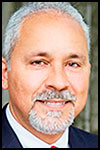Salam Noor: Oregon achieves together
Often when we look at education data, we become caught up in figures and percentages and forget the people the numbers represent. Looking at the statewide graduation data released last month, of the 46,000 students in the 2015-16 cohort, more than 34,000 received either a regular or modified diploma. That’s an increase of 1,300 students over the previous year and a significant gain in improving graduation outcomes in our state. But let’s not forget the 12,000 students in that group who didn’t cross the finish line and lack a high school diploma. This number is enough to fill Knight Arena for a University of Oregon basketball game.
Reducing that number is the goal of every educator and school district in the state. The good news is that through our collective efforts over the last few years — ODE, school district leaders, staff and communities working together — the number of students earning a high school diploma has been increasing. Although we still have an achievement gap, we have examples of districts using best practices that result in impressive gains, especially with historically underserved students. You can read more about this in the graduation brief our research staff released with the graduation rate data (“Oregon Students Continue to Improve On-Time Graduation Rate,” online at oregon.gov/ode/reports-and-data).
In my trips around the state talking with families, teachers, administrators and support staff, I hear three common themes:
n We need to raise the overall graduation rate;
n We need to reduce the opportunity gaps which cause many historically underserved student groups to graduate at a lower rate;
n We need to make sure students are graduating with the skills they need for college and a career.
As educators, we have a clear understanding of some of the barriers to graduation. ODE is actively working with partners, including districts and communities, to address them. We know that students who are chronically absent from school graduate at a much lower rate. We also understand that our schools need to be culturally relevant and responsive so that all students feel welcome and want to strive for their best. These opportunities can be achieved through a well-rounded and engaging education that prepares students for success during their K-12 education and for life after high school. As a result, Oregon’s Plan under the federal Every Student Succeeds Act that we will submit in April to the United States Department of Education will focus on improving student outcomes through a well-rounded education focused on high-quality instruction and founded on educational equity.
No one should be satisfied with a 75 percent graduation rate in Oregon, but the numbers released last month are encouraging. The graduation rate increased for every demographic student group, and rates for some of our historically underserved student populations increased at rates two or three times the statewide average, closing the gaps. But our work isn’t done. We need everyone focused on the goal of making sure every student finishes high school fully prepared to start their career or pursue a post-secondary education experience.
Our future workforce and the health of our communities and state depend on our success. But more than that, we have a duty and a moral imperative to our students to give them the tools for success they will use throughout their lives.










Comments